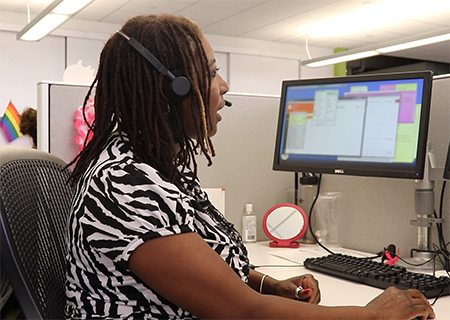Benefits Data Trust has ceased operations since this 2022 profile. For other organizations employing a similar model, see the “More Ways to Help” section at the bottom of this page.
Connect eligible people with benefits
Public benefit programs providing food, healthcare, and other assistance help ensure families and individuals can meet their basic needs. Even before the pandemic, eligible individuals and families struggled to access these programs, resulting in billions of unclaimed benefits per year. [1] The COVID-crisis increased the number of Americans applying for public assistance. Benefits Data Trust (BDT) leverages data, technology, and policy to help eligible people access essential benefits and services.
What It Does
 Founded in 2005 and headquartered in Philadelphia, BDT is a national nonprofit dedicated to streamlining access to benefits for millions of people in need. BDT does this through three, interrelated strategies:
Founded in 2005 and headquartered in Philadelphia, BDT is a national nonprofit dedicated to streamlining access to benefits for millions of people in need. BDT does this through three, interrelated strategies:
Direct service: BDT uses data-driven techniques to identify and reach out to low-income individuals who are likely eligible for public assistance, such as Supplemental Nutrition Assistance Program (SNAP) and Medicaid, encouraging them to call BDT for help in completing benefit applications. BDT’s proprietary data and technology systems allow it to screen people in seven states — Colorado, Maryland, Michigan, New York, North Carolina, South Carolina and Pennsylvania — for multiple benefits at once.
Improving government policy and practices: BDT works with the federal government, state agencies, and community partner organizations to promote policy solutions that streamline access to benefits.
Technology: BDT develops technology solutions such as tools for assessing eligibility and data-driven outreach and engagement. Such tools help meet demand and ensure equitable access to benefits at scale.
Calls to BDT spiked by 80% since the beginning of COVID-19, and included many first-time callers facing new unemployment. BDT increased its staff size by 50% to address the economic crisis sparked by COVID-19.
How Effective It Is
Since 2005, BDT has helped over 1 million households access more than $7.5 billion in public benefits. Research demonstrates that public benefits provide crucial support to low income Americans[2]. For example, a recent study found that participation by North Carolina older adults in SNAP is linked to better health outcomes and lower Medicaid spending[3]. Specifically, the enrollment rate was 7.6 times higher for individuals who received BDT’s outreach and application assistance, resulting in an estimated Medicaid cost-savings of $2,360 per person annually.
BDT also aims to improve economic mobility by connecting students to financial assistance so they can graduate at higher rates with less debt. In partnership with the College Board, BDT created Wyatt, a text message based chatbot that helps high school seniors complete the Free Application for Federal Student Aid (FAFSA). Between November 2020 and November 2021, BDT delivered an estimated $165 million in total benefit enrollments, including an estimated $24 million in federal, need-based grants for nearly 10,300 students.
How You Can Help
BDT’s work is funded by government agencies, philanthropy, and fee-for-service contracts. Approximately 55% of BDT’s revenue comes from philanthropic sources that backfill costs not covered by government reimbursement rates. BDT also uses philanthropic donations to promote streamlined policies and practices and to create innovative tools to simplify benefits access at scale. Learn more at bdtrust.org/donate.
More Ways to Help — Donors can help make public benefits more accessible by funding enrollment assistance, advocating for policy improvements, and improving the capacity of benefits administrators. For example, the nonprofit Single Stop supplies other nonprofits with technology to provide their clients with referrals to benefits and services, while its in-house tax program provides free tax preparation for 15,000 low-income families. In Chicago, Los Angeles, New York, and Washington, DC, LIFT coaches low-income parents to set goals like securing a safe home, living wages, and a better education, then connects them to the financial resources and networks they need to achieve those goals. Ninety-four percent of LIFT parents improve their finances within three months.
